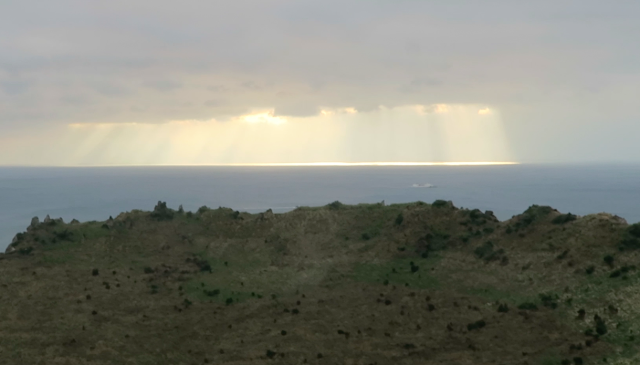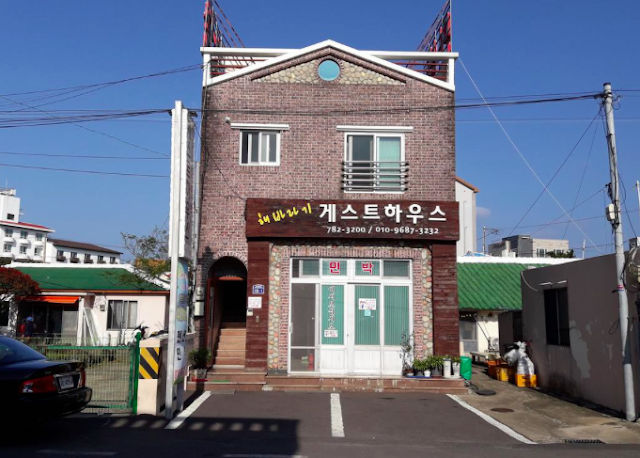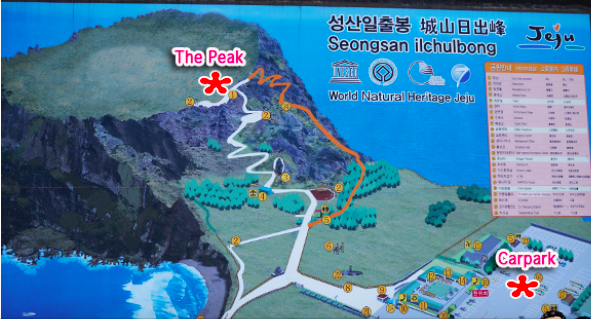If you know Chinese or Korean, you can probably recognize that its name is genius, encompassing two of it’s most salient features: Seongsan means a hill that can probably pass as a castle, and ilchulbong means the mountaintop where you should catch the sunrise
Rose from the ocean bed, Seongsan Ilchulbong was miraculously created in a Surtseyan-type hydrovolcanic eruption upon a shallow seabed 5 thousand years ago, featuring a huge crater at the top. The archetypal tuff cone crater is about 600m in diameter and 90m high, rises steeply up the edge with 99 sharp rocks encircling it, creating its distinctive crown or (some say,) castle look. At the center, the crater is bowl-shaped. While the southeast and north sides are made of cliffs and rocky outcrops, the northwest side formed a verdant grassy hill that is connected to the (later,) Seongsan Village. Though ancient people used to farm around the area, it is now a natural habitat for impressive 200 types of vegetation such as silvergrass, vine, Pseudosasa japonica, and giant angelica
Now, not only it is designated a Natural Monument on July 19, 2000, it is recognized as a UNESCO World Heritage Site in 2007 (inevitably), Global Geopark site in 2010, and last but not least, It was also gloriously named as one of the seven wonders of nature in the world since 2011.
Hence, by now I think you’ve got the message: no trip to Jeju is complete without a hike up the ‘Sunrise Peak’. As the name suggests, Seongsan Ilchulbong (a.k.a. Sunrise Peak) is one of the best places in Jeju to see the sunrise over the sea. Hence every year on 1st of January, people gather up at the top platform built on one end of the crater of Seongsan Ilchulbong to catch the first beam of the year. Seeing dawn break from the top of Seongsan Ilchulbong means a lot to the Koreans, as they believe that they will be granted good luck by the Gods.
Since 1994, a Sunrise Festival has been held at Seongsan Ilchulbong every year without fail. That was exactly the reason why I went to Jeju Island earlier this year, to join the party! It lasts from New Year’s Eve through the night, with a lot of fun activities, freebies to collect and free soup to taste! Right on 0:00, a marvelous firework show was sent into the air right above our heads while dancers continue performing on stage. There is a huge fireplace set up in the middle of the avenue and people will gather around and dance in circle. As dawn breaks, fishermen gathered their lit-up-boats in the ocean and blow their whistles in unison to welcome the New Year.
According to experienced hiker, it is really a sight to behold, but you’ll have to start the hike at 5 am (depending on the season) at the least to make it to the top on time! If your hotel is further away in Seogwipo or Jeju city, then you will have another hour to one and a half hour drive to go. So it means that to be on time to catch magical sunrise, you will need to be out of your bed at latest 3 am! Well, no pain no gain!
Please be advised that People with the following conditions should not hike the peak:
Diagnosed with hypertension, cardiac disorder, diabetes, drunk, pregnant women or senior citizens unable to carry out physical activity
Where to stay the night?
I definitely recommend staying near to Seongsan port as you don’t have to waste so much time on the road! If you are interested (why wouldn’t you be?), combine your visit to Seongsan Ichulbong with Udo Island. As in you’ll watch the sunrise at Seongsan Ichulbong first, then spend another 1-2 hours at the premise, then walk over to the port, catch a ferry to Udo Island and enjoy the rest of the day, Wallaaaaa!!!! A perfect plan!Recommended place to stay
1. For luxurious traveler/ newlywed couple: The Cloud (click to see on booking.com)
I absolutely love their outdoor swimming pool under the starry night. and not to mention the rooms with seaview! The hotel is located 1km from Seongsan Ilchulbong but it gives you a head start, good enough!
2. For budget travelers: Sunflower Minbak or Santiago
Both properties are located within 0.6 radius off Seongsan Ilchulbong's entrance. Plus, its budget friendly and you can meet travelers from all around the world.
What to prepare for the hike?
I’ve done some research and found people advising others to bring jackets on Tripadvisor. It makes sense coz as you ascend it’ll get colder and windier. Especially if you are hiking in wee hours for the sunrise! Foldable/ retractable hiking sticks may help too especially on the final steps or for elderly hikers. If not, you might need to use your hands to stabilize yourselves like these aunties in the photo below!We visited Seongsan Ilchulbong in January (winter) and started the hike at around 7 am. In our case, merely our autumn jackets were sufficient, no extra pullover needed as our body energy expenditure will turn into heat energy and subsequently warm up our body. wait am I being too scientific? No? Good. In fact, I sweated a lot and even craved for ice tea. Moral of the story, always checks the weather forecast before going out. If its windy, be prepared. If it is not, don’t overpack stuff, your back will suffer.
What you’ll really be needing, is water and maybe some energy bars, as there will be only 1 stall selling water along the trail.
How can I get there?
From the Jeju City Old Bus Terminal, the tourist bus will take you about 90 minutes. There are also some direct buses from Jeju Airport, which takes between an hour and a half to two hours. From Seogwipo, take bus number 101, and you will reach in about 90 minutes. To get a better picture of how to get there, I advise everyone to refer VisitJeju official page, which clearly describes Jeju’s Public Transportation System.For people who come directly from the airport or with huge luggage, there is a luggage storage room before the entrance.
If you are driving to Seongsan Ilchulbong, the Korean GPS coordination (by phone number) is 7830959 or 7107923. Parking is again, free!
Is the hike difficult?
Hiking up was pretty easy at the beginning part. You’ll pass a (slightly) bumpy stone pave first before arriving at the trailhead of the Sunrise peak. the Sunrise Peak trail was well marked, built up in zigzag mater towards the crater to ease the climb.First part, almost flat ground, with simple well paved steps. You'll ascend gradually with the view of the Seongsan Village in a distance.
Second part, as you hike up, the path will be lined by pine trees and bush.
Third part, path become narrower and the steps steeper as you go higher up. This is where you should start watching your steps.
The final part is relatively more difficult as the slope steepness grows more intense. Most of the elderly will stop ascending at this point as the younger ones go on. Some steps don’t have railings so you’ve got to be extra careful. Hiking sticks might help too but we completed the course without it totally fine.
We took 30 minutes uphill with frequent rest stop to replenish. Don’t rush it because every rest stop (mostly built out pavilions) turned as some great vantage points looking out to the sea and the path we took. Each point offers a different view.
Hydration is important. Don’t fret it, if you need a toilet break, washrooms are available along the way (however, be warned that it might get crowded during high season).
You will know when reaching the peak as you'll be greeted by large platform with benches letting visitors sit back relax and enjoy the sunrise. If you are already late, like me, the platform still have something for you: it enables visitors to enjoy a 360-degree view of the area!
The descending trail is a joy and view to behold. Don't believe me? Here are some photos I randomly (or intentionally) snapped on the way down!
The peak is 182 meters (600 ft) above sea level, and there are 2 separated hiking trails uphill, you can see it on a huge signboard in front of the starting point. I recommend taking the white path up and the orange path down as everyone else. Plus point, the air sure is refreshing with lovely pine trees lining the path!
What else to do in Seongsan Ilchulbong?
First thing first, EAT! Before we conquered Seongsan Ilchulbong, me and my brother make our way to the streets to taste some local delicacies. He had a BBQ beef skewer before entering the hiking ground while I choose to have my breakfast onsite. A Odeng/ Eomuk-Tang. These are fishcake on skewers served with hot soup, very delightful during winter months!If you came down before 1.30pm or 3 pm, you will be just in time to catch the Jeju island Woman Diver (Haenyo) in action. What can you expect is the Haenyeo will dive into the sea and later reappear with a handful of fresh catch such as abalone, seaweed, sea cucumber, oysters, octopus or even crabs. You can even tell the position of the diving Hainyeos from afar by their orange bobbing floats.
You might be asking what are Haenyeos…. Haenyeo (also spelled haenyo) (Hangul: 해녀; lit. sea women) are a group of old female divers (mostly in their 80s) who dives without sophisticated equipment in the Korean province of Jeju. Without an oxygen tank, mask or pressure controllers, they dive into the seabed to collect seafood, some are trained to hold their breathe up to 3 minutes (or more!) Hence they are often called the mermaids of Jeju. Known for their independent spirit, iron will, and determination, as they took over the job from men since the late 17th century. The Culture of Jeju Haenyeo was designated as the UNESCO Intangible Cultural Heritage of Humanity in 2016. The haenyeo are representative of the semi-matriarchal family structure of Jeju.
I didn't manage to watch it as I was there too early and didn’t have the will to wait another 2 hours plus for it. However, no regrets, since I got some interesting photos by Hainyeo’s little restaurant hut.
Continue hunting around for more photo opportunity!
Horseback riding is available too if you are interested. There is an old saying in South Korean saying "A human should be sent to Hanyanag (old name for Seoul), and a horse to Jeju Island"... Hence you know this is the place to get your epic horse riding experience! Imagine you enjoying the ride on the beach with the beautiful Seongsan Ilchulbong as the backdrop. Gorgeous, isn't it?
After visiting `Seongsan Ilchulbong, don't rush away! stay for a little sightseeing at Gwangchigi Beach, as the view of that Seongsan Ilchulbong from this particular point is absolutely stunning.
How much does entrance to the peak cost?
To ascend Seongsan Ilchulbong, you’ll have to pay:Individuals - Adults 2,000 won / Teenagers 1,000 won / Children 1,000 won
Groups - Adults 1,600 won / Teenagers 800 won / Children 800 won
Seniors 65 years and older, children 6 years and younger: Free
The fee goes towards keeping the trails impeccably maintained.
Operating Hours
April-October 07:00-20:00November-March 07:30-19:00
* Visitors must purchase tickets at least 20 minutes in advance before closing time.
--------------
Thank You for Reading! This post is based solely on my honest opinion or personal experience. If you have a different opinion, feel free to share your thoughts with me by commenting below!
------------------------
Follow me on Instagram if you would like to see more photos!
📌For more travel tips, like Eat Love Travel Breathe with Miss HappyFeet.
📌Subscribe to the monthly newsletter for exclusive travel deals, tips, free E-books, monthly giveaway and travel coupons!


































No comments:
Post a Comment